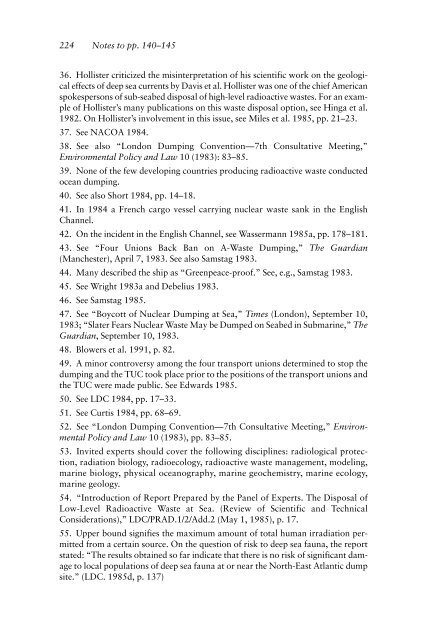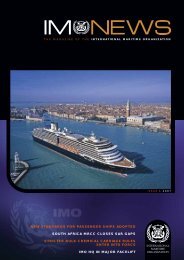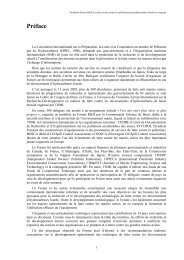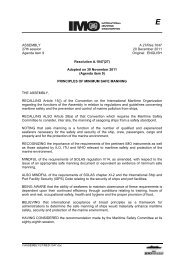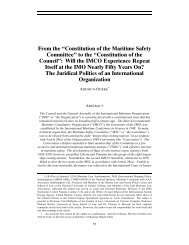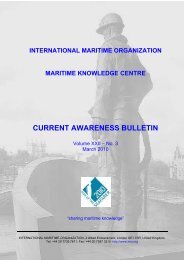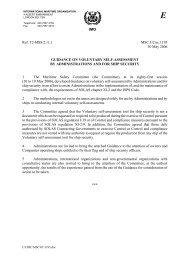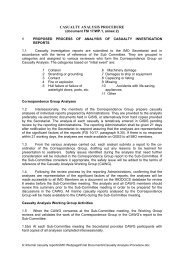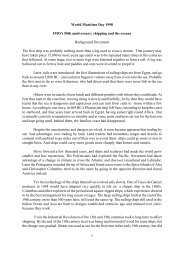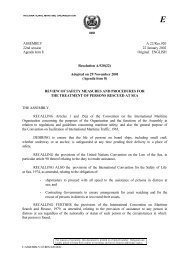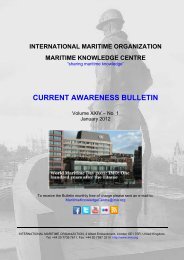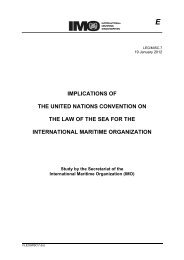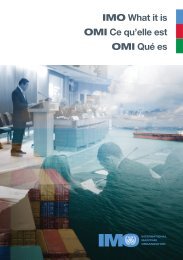Radioactive Waste Disposal at Sea: Public Ideas ... - IMO
Radioactive Waste Disposal at Sea: Public Ideas ... - IMO
Radioactive Waste Disposal at Sea: Public Ideas ... - IMO
Create successful ePaper yourself
Turn your PDF publications into a flip-book with our unique Google optimized e-Paper software.
224 Notes to pp. 140–145<br />
36. Hollister criticized the misinterpret<strong>at</strong>ion of his scientific work on the geological<br />
effects of deep sea currents by Davis et al. Hollister was one of the chief American<br />
spokespersons of sub-seabed disposal of high-level radioactive wastes. For an example<br />
of Hollister’s many public<strong>at</strong>ions on this waste disposal option, see Hinga et al.<br />
1982. On Hollister’s involvement in this issue, see Miles et al. 1985, pp. 21–23.<br />
37. See NACOA 1984.<br />
38. See also “London Dumping Convention—7th Consult<strong>at</strong>ive Meeting,”<br />
Environmental Policy and Law 10 (1983): 83–85.<br />
39. None of the few developing countries producing radioactive waste conducted<br />
ocean dumping.<br />
40. See also Short 1984, pp. 14–18.<br />
41. In 1984 a French cargo vessel carrying nuclear waste sank in the English<br />
Channel.<br />
42. On the incident in the English Channel, see Wassermann 1985a, pp. 178–181.<br />
43. See “Four Unions Back Ban on A-<strong>Waste</strong> Dumping,” The Guardian<br />
(Manchester), April 7, 1983. See also Samstag 1983.<br />
44. Many described the ship as “Greenpeace-proof.” See, e.g., Samstag 1983.<br />
45. See Wright 1983a and Debelius 1983.<br />
46. See Samstag 1985.<br />
47. See “Boycott of Nuclear Dumping <strong>at</strong> <strong>Sea</strong>,” Times (London), September 10,<br />
1983; “Sl<strong>at</strong>er Fears Nuclear <strong>Waste</strong> May be Dumped on <strong>Sea</strong>bed in Submarine,” The<br />
Guardian, September 10, 1983.<br />
48. Blowers et al. 1991, p. 82.<br />
49. A minor controversy among the four transport unions determined to stop the<br />
dumping and the TUC took place prior to the positions of the transport unions and<br />
the TUC were made public. See Edwards 1985.<br />
50. See LDC 1984, pp. 17–33.<br />
51. See Curtis 1984, pp. 68–69.<br />
52. See “London Dumping Convention—7th Consult<strong>at</strong>ive Meeting,” Environmental<br />
Policy and Law 10 (1983), pp. 83–85.<br />
53. Invited experts should cover the following disciplines: radiological protection,<br />
radi<strong>at</strong>ion biology, radioecology, radioactive waste management, modeling,<br />
marine biology, physical oceanography, marine geochemistry, marine ecology,<br />
marine geology.<br />
54. “Introduction of Report Prepared by the Panel of Experts. The <strong>Disposal</strong> of<br />
Low-Level <strong>Radioactive</strong> <strong>Waste</strong> <strong>at</strong> <strong>Sea</strong>. (Review of Scientific and Technical<br />
Consider<strong>at</strong>ions),” LDC/PRAD.1/2/Add.2 (May 1, 1985), p. 17.<br />
55. Upper bound signifies the maximum amount of total human irradi<strong>at</strong>ion permitted<br />
from a certain source. On the question of risk to deep sea fauna, the report<br />
st<strong>at</strong>ed: “The results obtained so far indic<strong>at</strong>e th<strong>at</strong> there is no risk of significant damage<br />
to local popul<strong>at</strong>ions of deep sea fauna <strong>at</strong> or near the North-East Atlantic dump<br />
site.” (LDC. 1985d, p. 137)


